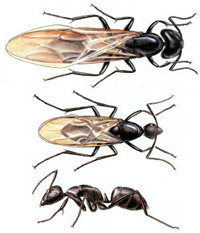|  Carpenter
Ants Carpenter
Ants
Order: Hymenoptera
Family: Formicidae
Scientific Name: Camponotus pennsylvanicus (DeGreer)
Color: Varies depending on species, from red to
black or a combination. The two most common species are black.
Legs: Six
Shape: Segmented, oval, one spike between thorax
and abdomen
Size: varies; workers, 1/4-5/8"; queen, 3/4"
Antennae: Yes
Flight: No, although reproductives may have wings.
Carpenter ants are found in all contiguous states. They get their
name because they excavate wood in order to build their nests. Their
excavation results in smooth tunnels inside the wood. Carpenter
ants range in size from one-quarter inch for a worker ant to up
to three-quarters inch for a queen. A colony can contain over 3,000
workers or 10-15,000 including all satellite nests.
Habits
All species mainly attack wood that is or has been wet and damaged
by mold. Even though these ants first invade wet, decayed wood,
they may soon begin building paths through dry, undamaged wood.
They usually come into buildings through cracks around doors, windows,
or through holes for wires. They will also crawl along overhead
wires, shrubs, or tree limbs that touch the building far above the
ground. Adult workers are mostly active at night, between 10 pm
and 2 am, although it is not uncommon to see workers foraging during
the day. Carpenter ants may travel up to 100 yards from the colony
serching for food.
Habitat
Carpenter ants build their nests outdoors in various wood sources,
including tree stumps, firewood or landscaping. They need a constant
water source to survive. They will enter homes through wet, damaged
wood.
Carpenter ants may create satellite colonies which are away from
the primary colony where the queen resides. Typically, the satellite
colony consists of workers, larvae and pupae and, if in a house,
is usually located in a wall void, attic and other hollow void area.
Piles of "sawdust" may be a sign of Carpenter ant activity.
The frass (sawdust) is usually contains pieces of dead ants and
other insects. Other signs of Carpenter ants are the presence of
workers or reproductives, scratching sounds coming from a wall or
void area made by the ants when the colony is disturbed.
Threats
Carpenter ants damage wood through their nest building. If they
gain entry to a structure, they pose a property threat that may
result in structural damage.
Control
Because carpenter ants require a water source, eliminate sources
of moisture or standing water. Keep tree branches and other plants
cut back from the house. Sometimes pests use these branches to get
into your home. Make sure that there are no cracks or little openings
around the bottom of your house. Sometimes pests use these to get
into your home. Make sure that firewood and building materials are
not stored next to your home. Pests like to build nests in stacks
of wood. Cut down and dispose of dead trees and limbs.
The key to eliminating a Carpenter ant infestation is to locate
the primary and all satellite colonies. Treat the colonies directly
with an insecticide formulated as a liquid or dust. THis may require
drilling into wall or other void areas.
(Source: National Pest Management Association, et. al.)
|